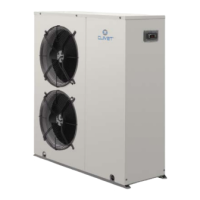10 WSAT-XIN 21-171 M0Q940G14-03
4 Positioning
During positioning consider these elements:
•
Technical spaces requested by the unit
•
Electrical connections
•
Water connections
•
Spaces for air exhaust and intake
4.1 Functional spaces
Functional spaces are designed to:
•
guarantee good unit operation
•
carry out maintenance operations
•
protect authorized operators and exposed people
Respect all functional spaces indicated in the DIMENSIONS section.
Double all functional spaces if two or more unit are aligned.
4.2 Positioning
Units are designed to be installed:
•
EXTERNAL
•
in xed positions
Limit vibration transmission:
•
use antivibration devices on unit bearing points
•
install exible joints on the hydraulic connections
Choose the installation place according to the following criteria:
•
Customer approval
•
safe accessible position
•
technical spaces requested by the unit
•
spaces for the air intake/exhaust
•
The device prevents any impurity in the water circuit to dirt the heat exchanger.
•
verify unit weight and bearing point capacity
•
verify that all bearing points are aligned and leveled
•
install the unit raised from the ground
•
max. distance allowed by the electrical connections
Prefer places where the unit doesn’t disturb the neighbours.
Avoid installations next to bedrooms or windows.
A correct circulation of the air is mandatory to guarantee the good unit operating.
Avoid therefore:
•
obstacles to the airow
•
diculty of exchange
•
leaves or other foreign bodies that can obstruct the air coil
•
winds that hinder or favour the airow
•
heat or pollution sources close to the unit (chimneys, extractors etc..)
•
stratication (cold air that stagnates at the bottom)
•
recirculation (expelled air that is sucked in again)
•
incorrect positioning, close to very high walls, attics or in angles that could give rise to stratication or recirculation phenomenons
Ignoring the previous indications could:
•
reduce energy eciency
•
alarm lockout due to HIGH PRESSURE (in summer) or LOW PRESSURE (in winter)

